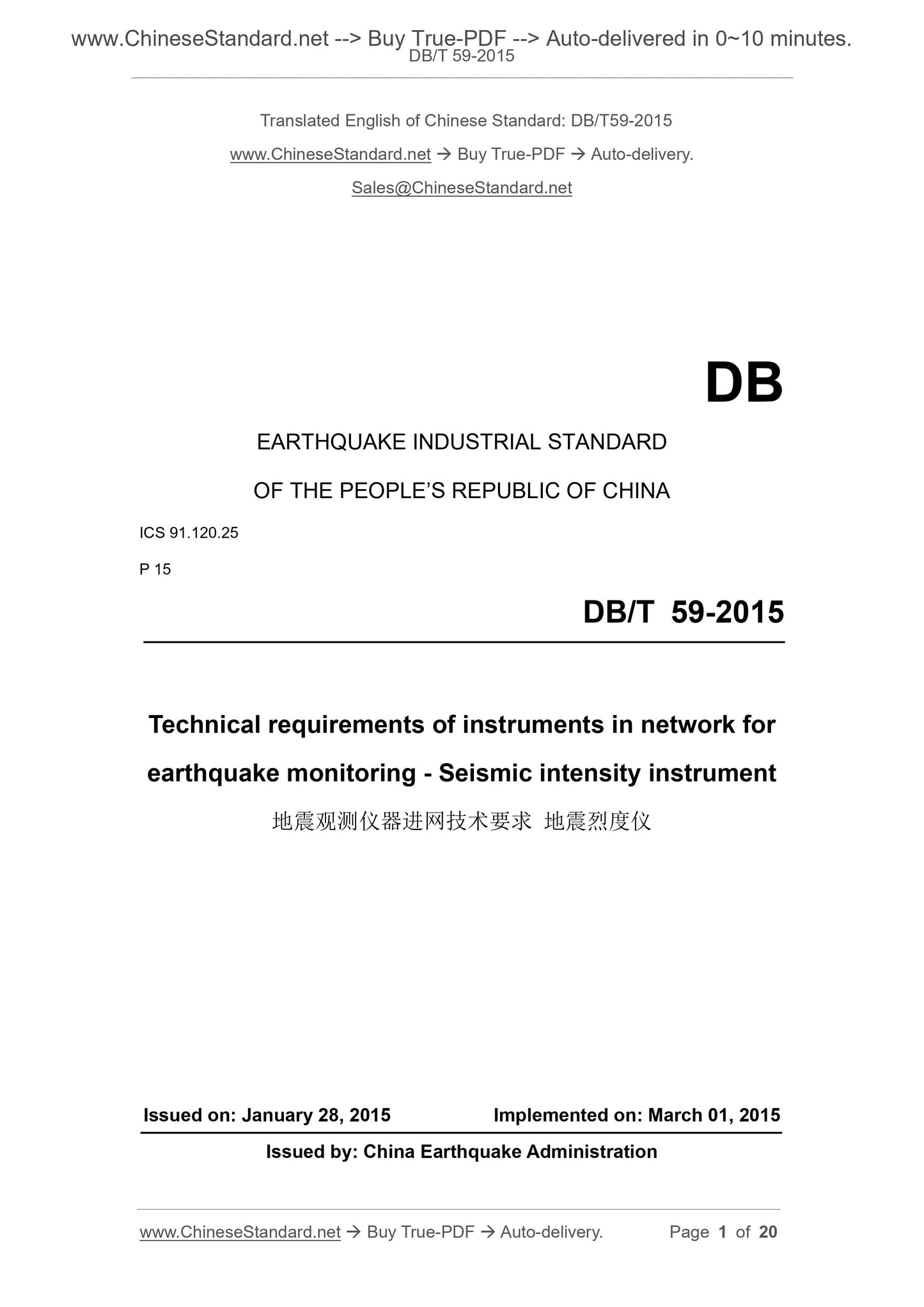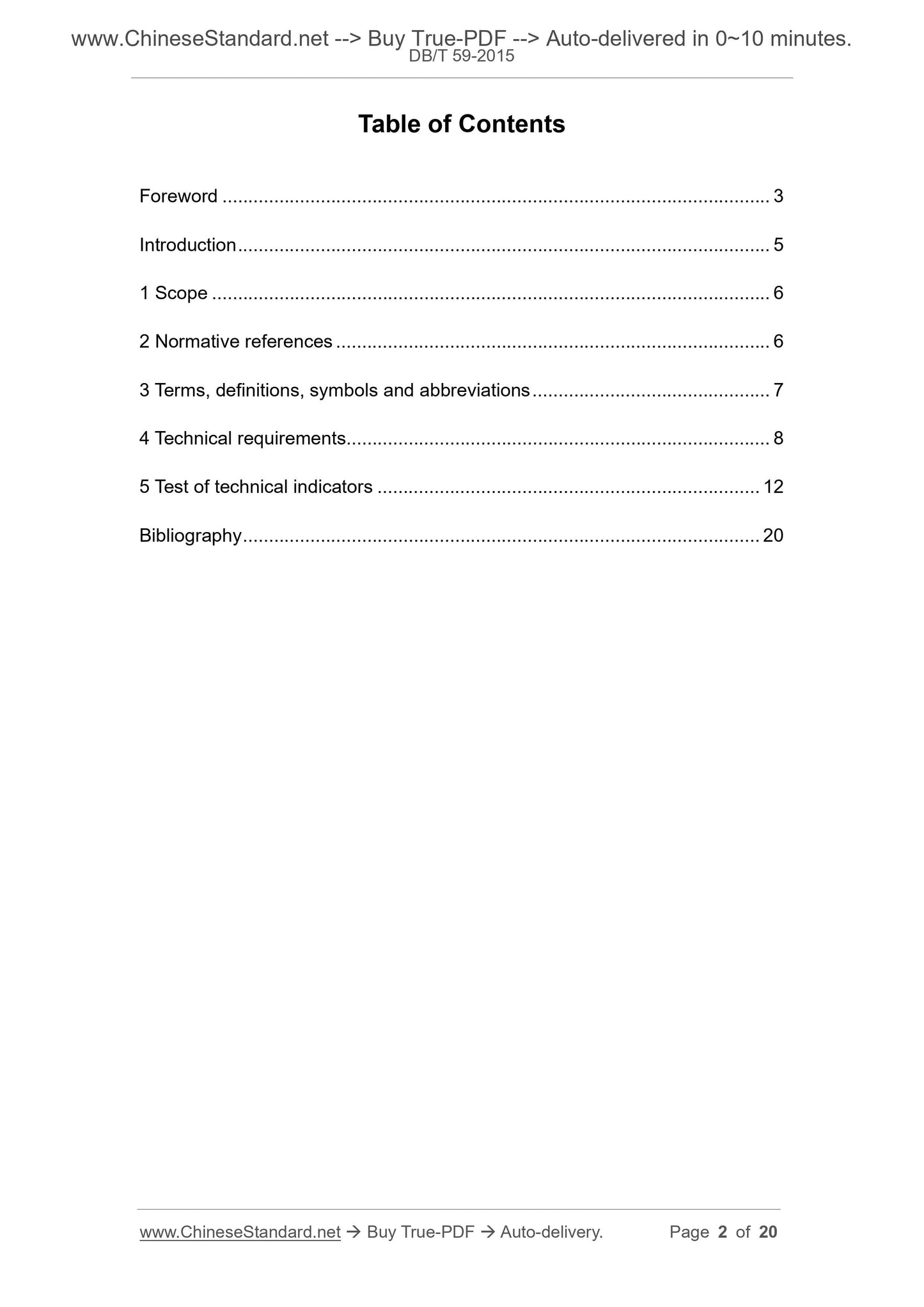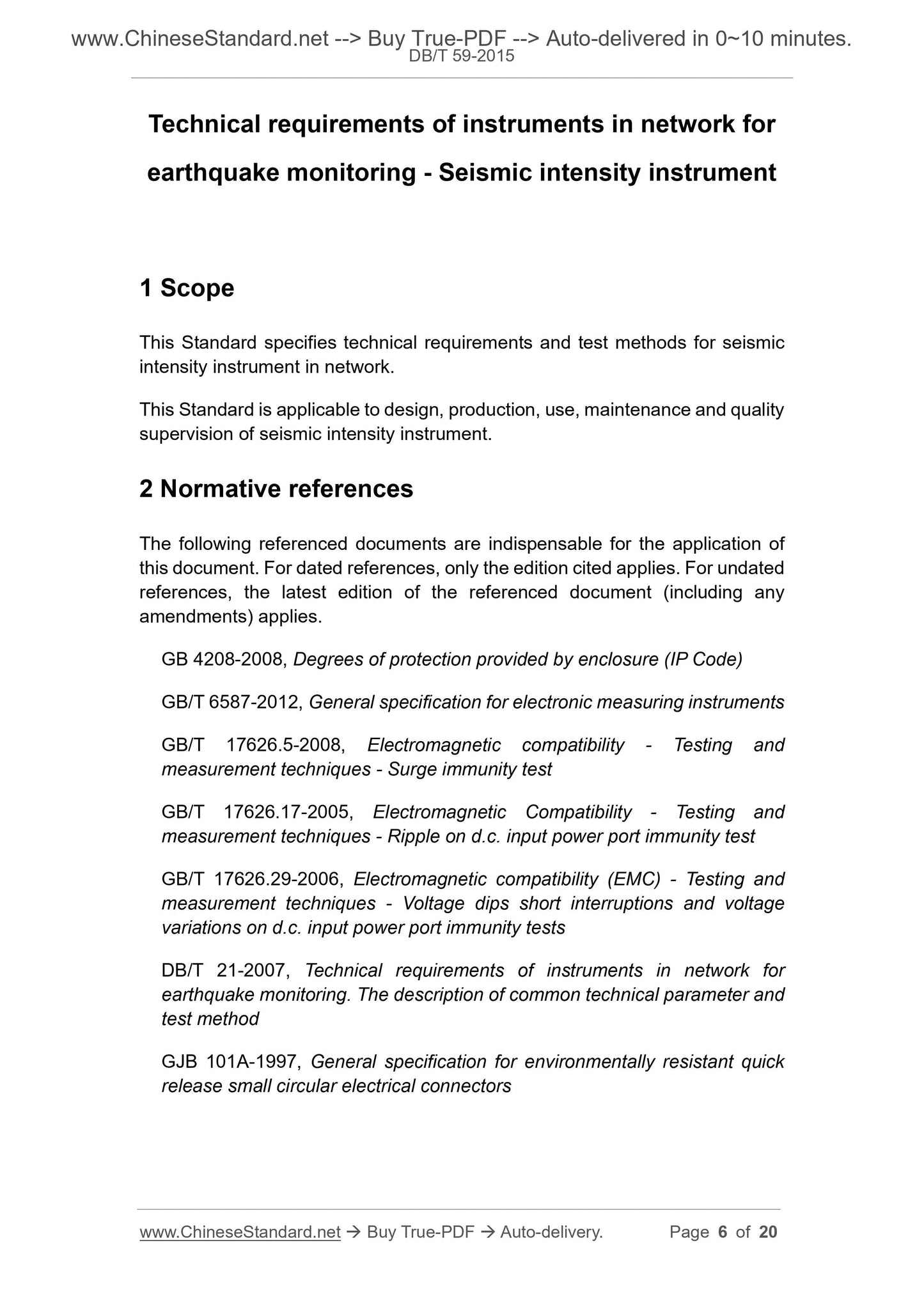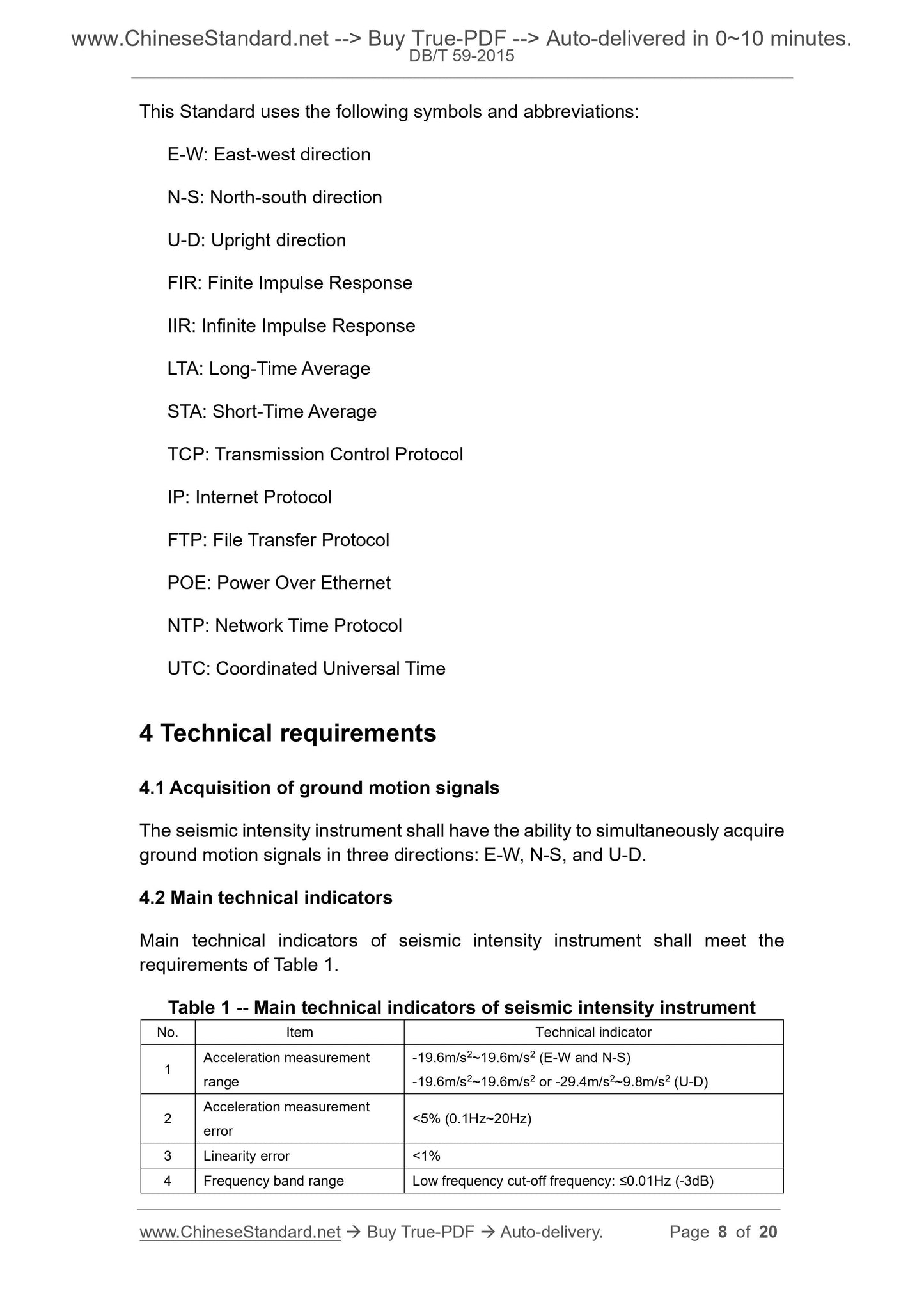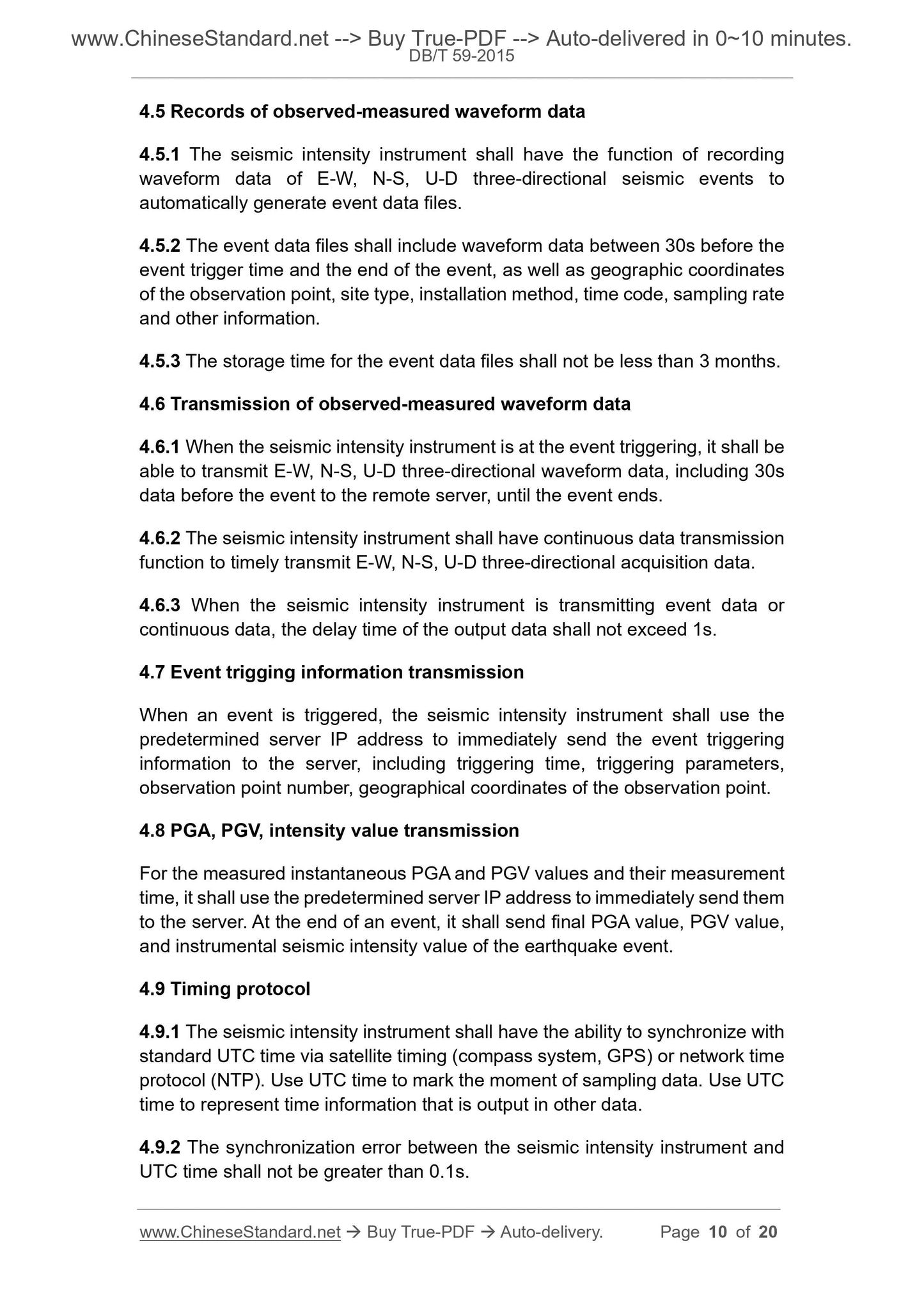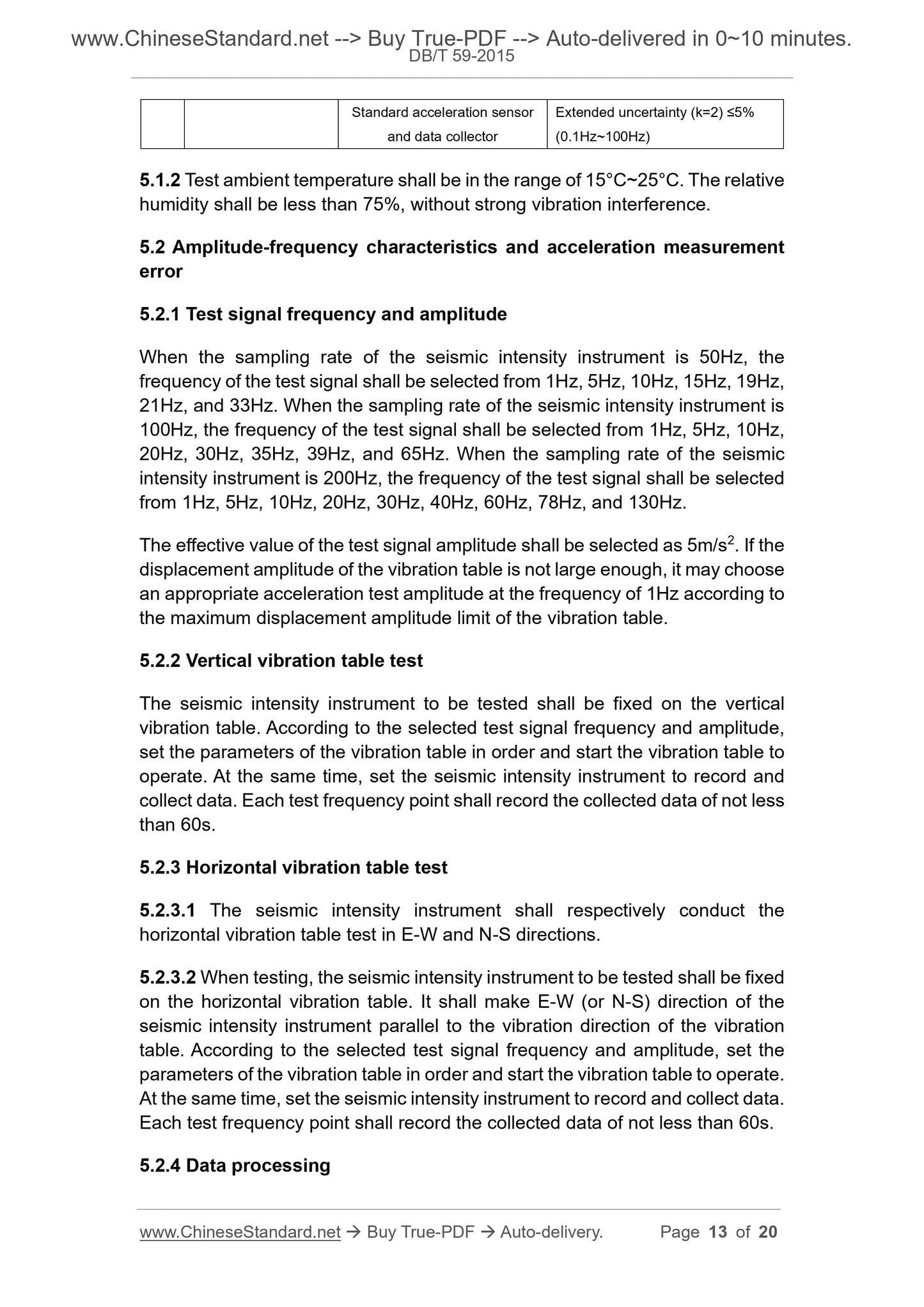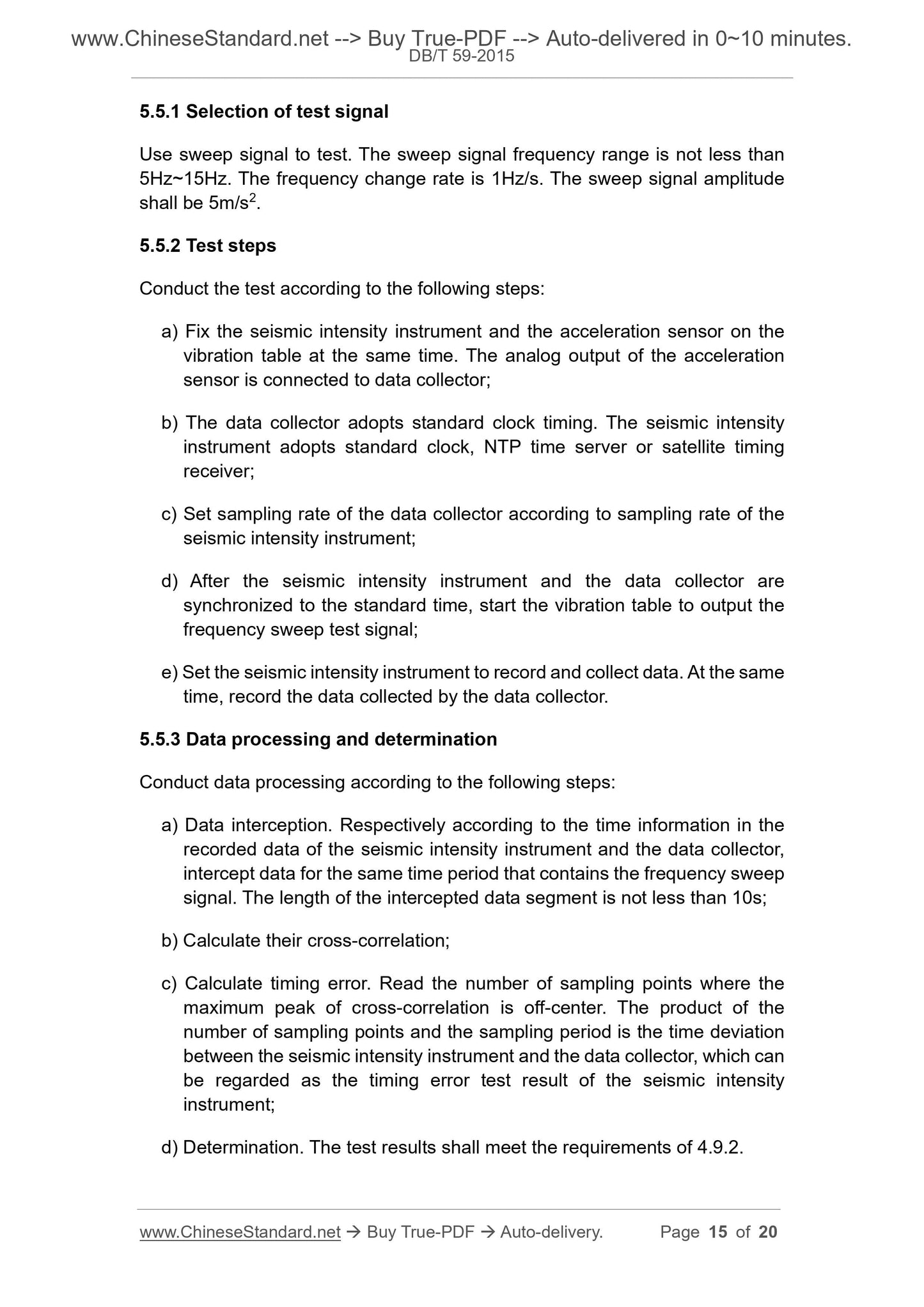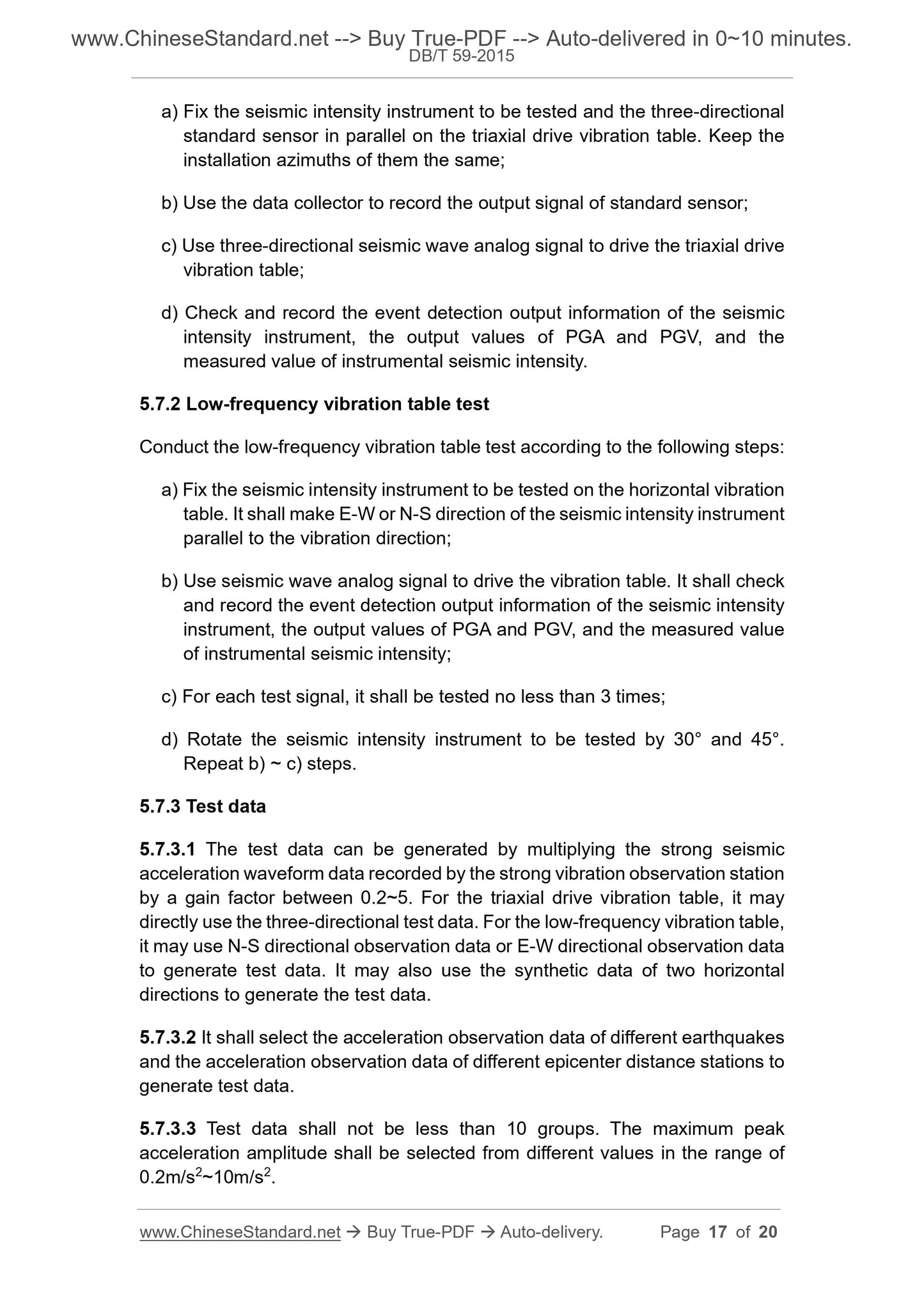1
/
의
8
PayPal, credit cards. Download editable-PDF and invoice in 1 second!
DB/T 59-2015 English PDF (DBT59-2015)
DB/T 59-2015 English PDF (DBT59-2015)
정가
$165.00 USD
정가
할인가
$165.00 USD
단가
/
단위
배송료는 결제 시 계산됩니다.
픽업 사용 가능 여부를 로드할 수 없습니다.
Delivery: 3 seconds. Download true-PDF + Invoice.
Get QUOTATION in 1-minute: Click DB/T 59-2015
Historical versions: DB/T 59-2015
Preview True-PDF (Reload/Scroll if blank)
DB/T 59-2015: Technical requirements of instruments in network for earthquake monitoring - Seismic intensity instrument
DB/T 59-2015
EARTHQUAKE INDUSTRIAL STANDARD
OF THE PEOPLE’S REPUBLIC OF CHINA
ICS 91.120.25
P 15
Technical requirements of instruments in network for
earthquake monitoring - Seismic intensity instrument
ISSUED ON: JANUARY 28, 2015
IMPLEMENTED ON: MARCH 01, 2015
Issued by: China Earthquake Administration
Table of Contents
Foreword ... 3
Introduction ... 5
1 Scope ... 6
2 Normative references ... 6
3 Terms, definitions, symbols and abbreviations ... 7
4 Technical requirements ... 8
5 Test of technical indicators ... 12
Bibliography ... 20
Technical requirements of instruments in network for
earthquake monitoring - Seismic intensity instrument
1 Scope
This Standard specifies technical requirements and test methods for seismic
intensity instrument in network.
This Standard is applicable to design, production, use, maintenance and quality
supervision of seismic intensity instrument.
2 Normative references
The following referenced documents are indispensable for the application of
this document. For dated references, only the edition cited applies. For undated
references, the latest edition of the referenced document (including any
amendments) applies.
GB 4208-2008, Degrees of protection provided by enclosure (IP Code)
GB/T 6587-2012, General specification for electronic measuring instruments
GB/T 17626.5-2008, Electromagnetic compatibility - Testing and
measurement techniques - Surge immunity test
GB/T 17626.17-2005, Electromagnetic Compatibility - Testing and
measurement techniques - Ripple on d.c. input power port immunity test
GB/T 17626.29-2006, Electromagnetic compatibility (EMC) - Testing and
measurement techniques - Voltage dips short interruptions and voltage
variations on d.c. input power port immunity tests
DB/T 21-2007, Technical requirements of instruments in network for
earthquake monitoring. The description of common technical parameter and
test method
GJB 101A-1997, General specification for environmentally resistant quick
release small circular electrical connectors
This Standard uses the following symbols and abbreviations:
E-W: East-west direction
N-S: North-south direction
U-D: Upright direction
FIR: Finite Impulse Response
IIR: Infinite Impulse Response
LTA: Long-Time Average
STA: Short-Time Average
TCP: Transmission Control Protocol
IP: Internet Protocol
FTP: File Transfer Protocol
POE: Power Over Ethernet
NTP: Network Time Protocol
UTC: Coordinated Universal Time
4 Technical requirements
4.1 Acquisition of ground motion signals
The seismic intensity instrument shall have the ability to simultaneously acquire
ground motion signals in three directions: E-W, N-S, and U-D.
4.2 Main technical indicators
Main technical indicators of seismic intensity instrument shall meet the
requirements of Table 1.
Table 1 -- Main technical indicators of seismic intensity instrument
No. Item Technical indicator
1 Acceleration measurement range
-19.6m/s2~19.6m/s2 (E-W and N-S)
-19.6m/s2~19.6m/s2 or -29.4m/s2~9.8m/s2 (U-D)
2 Acceleration measurement error < 5% (0.1Hz~20Hz)
3 Linearity error < 1%
4 Frequency band range Low frequency cut-off frequency: ≤0.01Hz (-3dB)
4.5 Records of observed-measured waveform data
4.5.1 The seismic intensity instrument shall have the function of recording
waveform data of E-W, N-S, U-D three-directional seismic events to
automatically generate event data files.
4.5.2 The event data files shall include waveform data between 30s before the
event trigger time and the end of the event, as well as geographic coordinates
of the observation point, site type, installation method, time code, sampling rate
and other information.
4.5.3 The storage time for the event data files shall not be less than 3 months.
4.6 Transmission of observed-measured waveform data
4.6.1 When the seismic intensity instrument is at the event triggering, it shall be
able to transmit E-W, N-S, U-D three-directional waveform data, including 30s
data before the event to the remote server, until the event ends.
4.6.2 The seismic intensity instrument shall have continuous data transmission
function to timely transmit E-W, N-S, U-D three-directional acquisition data.
4.6.3 When the seismic intensity instrument is transmitting event data or
continuous data, the delay time of the output data shall not exceed 1s.
4.7 Event trigging information transmission
When an event is triggered, the seismic intensity instrument shall use the
predetermined server IP address to immediately send the event triggering
information to the server, including triggering time, triggering parameters,
observation point number, geographical coordinates of the observation point.
4.8 PGA, PGV, intensity value transmission
For the measured instantaneous PGA and PGV values and their measurement
time, it shall use the predetermined server IP address to immediately send them
to the server. At the end of an event, it shall send final PGA value, PGV value,
and instrumental seismic intensity value of the earthquake event.
4.9 Timing protocol
4.9.1 The seismic intensity instrument shall have the ability to synchronize with
standard UTC time via satellite timing (compass system, GPS) or network time
protocol (NTP). Use UTC time to mark the moment of sampling data. Use UTC
time to represent time information that is output in other data.
4.9.2 The synchronization error between the seismic intensity instrument and
UTC time shall not be greater than 0.1s.
Standard acceleration sensor
and data collector
Extended uncertainty (k=2) ≤5%
(0.1Hz~100Hz)
5.1.2 Test ambient temperature shall be in the range of 15°C~25°C. The relative
humidity shall be less than 75%, without strong vibration interference.
5.2 Amplitude-frequency characteristics and acceleration measurement
error
5.2.1 Test signal frequency and amplitude
When the sampling rate of the seismic intensity instrument is 50Hz, the
frequency of the test signal shall be selected from 1Hz, 5Hz, 10Hz, 15Hz, 19Hz,
21Hz, and 33Hz. When the sampling rate of the seismic intensity instrument is
100Hz, the frequency of the test signal shall be selected from 1Hz, 5Hz, 10Hz,
20Hz, 30Hz, 35Hz, 39Hz, and 65Hz. When the sampling rate of the seismic
intensity instrument is 200Hz, the frequency of the test signal shall be selected
from 1Hz, 5Hz, 10Hz, 20Hz, 30Hz, 40Hz, 60Hz, 78Hz, and 130Hz.
The effective value of the test signal amplitude shall be selected as 5m/s2. If the
displacement amplitude of the vibration table is not large enough, it may choose
an appropriate acceleration test amplitude at the frequency of 1Hz according to
the maximum displacement amplitude limit of the vibration table.
5.2.2 Vertical vibration table test
The seismic intensity instrument to be tested shall be fixed on the vertical
vibration table. According to the selected test signal frequency and amplitude,
set the parameters of the vibration table in order and start the vibration table to
operate. At the same time, set the seismic intensity instrument to record and
collect data. Each test frequency point shall record the collected data of not less
than 60s.
5.2.3 Horizontal vibration table test
5.2.3.1 The seismic intensity instrument shall respectively conduct the
horizontal vibration table test in E-W and N-S directions.
5.2.3.2 When testing, the seismic intensity instrument to be tested shall be fixed
o...
Get QUOTATION in 1-minute: Click DB/T 59-2015
Historical versions: DB/T 59-2015
Preview True-PDF (Reload/Scroll if blank)
DB/T 59-2015: Technical requirements of instruments in network for earthquake monitoring - Seismic intensity instrument
DB/T 59-2015
EARTHQUAKE INDUSTRIAL STANDARD
OF THE PEOPLE’S REPUBLIC OF CHINA
ICS 91.120.25
P 15
Technical requirements of instruments in network for
earthquake monitoring - Seismic intensity instrument
ISSUED ON: JANUARY 28, 2015
IMPLEMENTED ON: MARCH 01, 2015
Issued by: China Earthquake Administration
Table of Contents
Foreword ... 3
Introduction ... 5
1 Scope ... 6
2 Normative references ... 6
3 Terms, definitions, symbols and abbreviations ... 7
4 Technical requirements ... 8
5 Test of technical indicators ... 12
Bibliography ... 20
Technical requirements of instruments in network for
earthquake monitoring - Seismic intensity instrument
1 Scope
This Standard specifies technical requirements and test methods for seismic
intensity instrument in network.
This Standard is applicable to design, production, use, maintenance and quality
supervision of seismic intensity instrument.
2 Normative references
The following referenced documents are indispensable for the application of
this document. For dated references, only the edition cited applies. For undated
references, the latest edition of the referenced document (including any
amendments) applies.
GB 4208-2008, Degrees of protection provided by enclosure (IP Code)
GB/T 6587-2012, General specification for electronic measuring instruments
GB/T 17626.5-2008, Electromagnetic compatibility - Testing and
measurement techniques - Surge immunity test
GB/T 17626.17-2005, Electromagnetic Compatibility - Testing and
measurement techniques - Ripple on d.c. input power port immunity test
GB/T 17626.29-2006, Electromagnetic compatibility (EMC) - Testing and
measurement techniques - Voltage dips short interruptions and voltage
variations on d.c. input power port immunity tests
DB/T 21-2007, Technical requirements of instruments in network for
earthquake monitoring. The description of common technical parameter and
test method
GJB 101A-1997, General specification for environmentally resistant quick
release small circular electrical connectors
This Standard uses the following symbols and abbreviations:
E-W: East-west direction
N-S: North-south direction
U-D: Upright direction
FIR: Finite Impulse Response
IIR: Infinite Impulse Response
LTA: Long-Time Average
STA: Short-Time Average
TCP: Transmission Control Protocol
IP: Internet Protocol
FTP: File Transfer Protocol
POE: Power Over Ethernet
NTP: Network Time Protocol
UTC: Coordinated Universal Time
4 Technical requirements
4.1 Acquisition of ground motion signals
The seismic intensity instrument shall have the ability to simultaneously acquire
ground motion signals in three directions: E-W, N-S, and U-D.
4.2 Main technical indicators
Main technical indicators of seismic intensity instrument shall meet the
requirements of Table 1.
Table 1 -- Main technical indicators of seismic intensity instrument
No. Item Technical indicator
1 Acceleration measurement range
-19.6m/s2~19.6m/s2 (E-W and N-S)
-19.6m/s2~19.6m/s2 or -29.4m/s2~9.8m/s2 (U-D)
2 Acceleration measurement error < 5% (0.1Hz~20Hz)
3 Linearity error < 1%
4 Frequency band range Low frequency cut-off frequency: ≤0.01Hz (-3dB)
4.5 Records of observed-measured waveform data
4.5.1 The seismic intensity instrument shall have the function of recording
waveform data of E-W, N-S, U-D three-directional seismic events to
automatically generate event data files.
4.5.2 The event data files shall include waveform data between 30s before the
event trigger time and the end of the event, as well as geographic coordinates
of the observation point, site type, installation method, time code, sampling rate
and other information.
4.5.3 The storage time for the event data files shall not be less than 3 months.
4.6 Transmission of observed-measured waveform data
4.6.1 When the seismic intensity instrument is at the event triggering, it shall be
able to transmit E-W, N-S, U-D three-directional waveform data, including 30s
data before the event to the remote server, until the event ends.
4.6.2 The seismic intensity instrument shall have continuous data transmission
function to timely transmit E-W, N-S, U-D three-directional acquisition data.
4.6.3 When the seismic intensity instrument is transmitting event data or
continuous data, the delay time of the output data shall not exceed 1s.
4.7 Event trigging information transmission
When an event is triggered, the seismic intensity instrument shall use the
predetermined server IP address to immediately send the event triggering
information to the server, including triggering time, triggering parameters,
observation point number, geographical coordinates of the observation point.
4.8 PGA, PGV, intensity value transmission
For the measured instantaneous PGA and PGV values and their measurement
time, it shall use the predetermined server IP address to immediately send them
to the server. At the end of an event, it shall send final PGA value, PGV value,
and instrumental seismic intensity value of the earthquake event.
4.9 Timing protocol
4.9.1 The seismic intensity instrument shall have the ability to synchronize with
standard UTC time via satellite timing (compass system, GPS) or network time
protocol (NTP). Use UTC time to mark the moment of sampling data. Use UTC
time to represent time information that is output in other data.
4.9.2 The synchronization error between the seismic intensity instrument and
UTC time shall not be greater than 0.1s.
Standard acceleration sensor
and data collector
Extended uncertainty (k=2) ≤5%
(0.1Hz~100Hz)
5.1.2 Test ambient temperature shall be in the range of 15°C~25°C. The relative
humidity shall be less than 75%, without strong vibration interference.
5.2 Amplitude-frequency characteristics and acceleration measurement
error
5.2.1 Test signal frequency and amplitude
When the sampling rate of the seismic intensity instrument is 50Hz, the
frequency of the test signal shall be selected from 1Hz, 5Hz, 10Hz, 15Hz, 19Hz,
21Hz, and 33Hz. When the sampling rate of the seismic intensity instrument is
100Hz, the frequency of the test signal shall be selected from 1Hz, 5Hz, 10Hz,
20Hz, 30Hz, 35Hz, 39Hz, and 65Hz. When the sampling rate of the seismic
intensity instrument is 200Hz, the frequency of the test signal shall be selected
from 1Hz, 5Hz, 10Hz, 20Hz, 30Hz, 40Hz, 60Hz, 78Hz, and 130Hz.
The effective value of the test signal amplitude shall be selected as 5m/s2. If the
displacement amplitude of the vibration table is not large enough, it may choose
an appropriate acceleration test amplitude at the frequency of 1Hz according to
the maximum displacement amplitude limit of the vibration table.
5.2.2 Vertical vibration table test
The seismic intensity instrument to be tested shall be fixed on the vertical
vibration table. According to the selected test signal frequency and amplitude,
set the parameters of the vibration table in order and start the vibration table to
operate. At the same time, set the seismic intensity instrument to record and
collect data. Each test frequency point shall record the collected data of not less
than 60s.
5.2.3 Horizontal vibration table test
5.2.3.1 The seismic intensity instrument shall respectively conduct the
horizontal vibration table test in E-W and N-S directions.
5.2.3.2 When testing, the seismic intensity instrument to be tested shall be fixed
o...
Share
